A Novel 28-GHz Meta-Window for Millimeter-Wave Indoor Coverage
Abstract
1. Introduction
2. Design of 28-GHz Meta-Window
2.1. Principle of Meta-Window
2.2. Design and Simulation of Meta-Window Unit Cell
2.3. Design and Implementation of Meta-Window
- Substrate Preparation: Glass substrates undergo a two-stage pretreatment process involving cleaning and surface activation prior to metal deposition.
- Metal Deposition: Copper was deposited onto the glass substrate via sputtering, resulting in a uniform film thickness of 600 nm.
- Mask Fabrication: Photolithography was used for pattern transfer and mask preparation, including photoresist coating, exposure, and development.
- Patterning via Chemical Etching: Unprotected metal regions were selectively removed using wet chemical etching to form the final metallic wire patterns. Wet etching was chosen for its process simplicity, low cost, and scalability for large-area fabrication, resulting in a wire width of 50 m.
- Layer Stacking: Multilayer structures are edge bonded with adhesive, maintaining an air gap between layers, as illustrated in Figure 7a.
3. MmWave Communication Demonstrations Based on 28 GHz Meta-Window
3.1. MmWave Communication Performance After Meta-Window Focusing
3.2. MmWave Communication Performance of Meta-Window and 1-Bit DP-RRA Cascaded System
4. Conclusions
Author Contributions
Funding
Institutional Review Board Statement
Informed Consent Statement
Data Availability Statement
Conflicts of Interest
References
- Miao, H.; Zhang, J.; Tang, P.; Tian, L.; Zhao, X.; Guo, B.; Liu, G. Sub-6 GHz to mmWave for 5G-advanced and beyond: Channel measurements, characteristics and impact on system performance. IEEE J. Sel. Areas Commun. 2023, 41, 1945–1960. [Google Scholar] [CrossRef]
- Hong, W.; Jiang, Z.H.; Yu, C.; Hou, D.; Wang, H.; Guo, C.; Hu, Y.; Kuai, L.; Yu, Y.; Jiang, Z.; et al. The role of millimeter-wave technologies in 5G/6G wireless communications. IEEE J. Microw. 2021, 1, 101–122. [Google Scholar] [CrossRef]
- Rappaport, T.S.; Sun, S.; Mayzus, R.; Zhao, H.; Azar, Y.; Wang, K.; Wong, G.N.; Schulz, J.K.; Samimi, M.; Gutierrez, F. Millimeter wave mobile communications for 5G cellular: It will work! IEEE Access 2013, 1, 335–349. [Google Scholar] [CrossRef]
- Giordani, M.; Zorzi, M. Satellite communication at millimeter waves: A key enabler of the 6G era. In Proceedings of the 2020 International Conference on Computing, Networking and Communications (ICNC), Big Island, HI, USA, 17–20 February 2020; pp. 383–388. [Google Scholar]
- Uwaechia, A.N.; Mahyuddin, N.M. A comprehensive survey on millimeter wave communications for fifth-generation wireless networks: Feasibility and challenges. IEEE Access 2020, 8, 62367–62414. [Google Scholar] [CrossRef]
- Zekri, A.B.; Ajgou, R.; Chemsa, A.; Ghendir, S. Analysis of outdoor to indoor penetration loss for mmwave channels. In Proceedings of the 2020 1st International Conference on Communications, Control Systems and Signal Processing (CCSSP), El Oued, Algeria, 16–17 May 2020; pp. 74–79. [Google Scholar]
- Kodra, S.; Barbiroli, M.; Vitucci, E.M.; Fuschini, F.; Degli-Esposti, V. Mm-Wave Building Penetration Losses: A Measurement-Based Critical Analysis. IEEE Open J. Antennas Propag. 2024, 5, 404–413. [Google Scholar] [CrossRef]
- Lee, Y.C.; Oh, S.S.; Byeon, C.W.; Aziding, K.; Cho, B.L. Impact of window penetration loss on building entry loss from 3.5 to 24 GHz. IEEE Access 2021, 9, 138571–138579. [Google Scholar] [CrossRef]
- Khawaja, W.; Ozdemir, O.; Yapici, Y.; Erden, F.; Guvenc, I. Coverage enhancement for NLOS mmWave links using passive reflectors. IEEE Open J. Commun. Soc. 2020, 1, 263–281. [Google Scholar] [CrossRef]
- Naqvi, S.H.R.; Ho, P.H.; Peng, L. 5G NR mmWave indoor coverage with massive antenna system. J. Commun. Netw. 2021, 23, 1–11. [Google Scholar] [CrossRef]
- Fu, C.; Han, L.; Liu, C.; Lu, X.; Sun, Z. Combining Pancharatnam–Berry phase and conformal coding metasurface for dual-band RCS reduction. IEEE Trans. Antennas Propag. 2021, 70, 2352–2357. [Google Scholar] [CrossRef]
- Li, Y.; Lin, J.; Guo, H.; Sun, W.; Xiao, S.; Zhou, L. A tunable metasurface with switchable functionalities: From perfect transparency to perfect absorption. Adv. Opt. Mater. 2020, 8, 1901548. [Google Scholar] [CrossRef]
- Ji, W.; Chang, J.; Xu, H.X.; Gao, J.R.; Gröblacher, S.; Urbach, H.P.; Adam, A.J. Recent advances in metasurface design and quantum optics applications with machine learning, physics-informed neural networks, and topology optimization methods. Light Sci. Appl. 2023, 12, 169. [Google Scholar] [CrossRef]
- Lu, C.; Mei, Z.L.; Tang, W.X.; Cui, T.J. Manipulating scattering features by metamaterials. EPJ Appl. Metamater. 2016, 3, 3. [Google Scholar] [CrossRef]
- Fu, C.; Sun, Z.; Han, L.; Liu, C. Dual-bandwidth linear polarization converter based on anisotropic metasurface. IEEE Photonics J. 2020, 12, 1–11. [Google Scholar] [CrossRef]
- Fu, C.; Han, L.; Liu, C.; Sun, Z.; Lu, X. Dual-band polarization conversion metasurface for RCS reduction. IEEE Trans. Antennas Propag. 2020, 69, 3044–3049. [Google Scholar] [CrossRef]
- Cui, T.J.; Qi, M.Q.; Wan, X.; Zhao, J.; Cheng, Q. Coding metamaterials, digital metamaterials and programmable metamaterials. Light Sci. Appl. 2014, 3, e218. [Google Scholar] [CrossRef]
- Basar, E.; Di Renzo, M.; De Rosny, J.; Debbah, M.; Alouini, M.S.; Zhang, R. Wireless communications through reconfigurable intelligent surfaces. IEEE Access 2019, 7, 116753–116773. [Google Scholar] [CrossRef]
- Di Renzo, M.; Zappone, A.; Debbah, M.; Alouini, M.S.; Yuen, C.; De Rosny, J.; Tretyakov, S. Smart radio environments empowered by reconfigurable intelligent surfaces: How it works, state of research, and the road ahead. IEEE J. Sel. Areas Commun. 2020, 38, 2450–2525. [Google Scholar] [CrossRef]
- Liang, J.C.; Cheng, Q.; Gao, Y.; Xiao, C.; Gao, S.; Zhang, L.; Jin, S.; Cui, T.J. An angle-insensitive 3-bit reconfigurable intelligent surface. IEEE Trans. Antennas Propag. 2021, 70, 8798–8808. [Google Scholar] [CrossRef]
- Wang, M.; Liao, D.; Dai, J.Y.; Chan, C.H. Dual-polarized reconfigurable metasurface for multifunctional control of electromagnetic waves. IEEE Trans. Antennas Propag. 2022, 70, 4539–4548. [Google Scholar] [CrossRef]
- Chen, Y.; Ren, J.; Li, P.; Ren, X.; Wang, J.; Zhang, S.; Yin, Y. Design of 2-bit Single Linearly-Polarized Reconfigurable Intelligent Surface for Single-/Multi-Beam Scanning. IEEE Antennas Wirel. Propag. Lett. 2024, 23, 2366–2370. [Google Scholar] [CrossRef]
- Zhou, Y.; Ma, X.; Luo, Q.; Ma, Y.; Alexandropoulos, G.C.; Yang, X. Wideband sub-THz Reconfigurable Intelligent Surface Using Planar Tightly Coupled Dipoles. IEEE Antennas Wirel. Propag. Lett. 2024, 23, 3659–3663. [Google Scholar] [CrossRef]
- Machado, G.G.; Abbasi, M.A.B.; McKernan, A.; Gu, C.; Zelenchuk, D. Wideband dual-polarized 1-bit unit-cell design for mmwave reconfigurable intelligent surface. In Proceedings of the 2024 18th European Conference on Antennas and Propagation (EuCAP), Glasgow, UK, 17–22 March 2024; pp. 1–4. [Google Scholar]
- Liu, Y.; Liu, X.; Mu, X.; Hou, T.; Xu, J.; Di Renzo, M.; Al-Dhahir, N. Reconfigurable intelligent surfaces: Principles and opportunities. IEEE Commun. Surv. Tutor. 2021, 23, 1546–1577. [Google Scholar] [CrossRef]
- Kamalisarvestani, M.; Saidur, R.; Mekhilef, S.; Javadi, F. Performance, materials and coating technologies of thermochromic thin films on smart windows. Renew. Sustain. Energy Rev. 2013, 26, 353–364. [Google Scholar] [CrossRef]
- Castillo, M.S.; Liu, X.; Abd-AlHamid, F.; Connelly, K.; Wu, Y. Intelligent windows for electricity generation: A technologies review. Build. Simul. 2022, 15, 1747–1773. [Google Scholar] [CrossRef]
- Yunos, L.; Jane, M.L.; Murphy, P.J.; Zuber, K. Frequency selective surface on low emissivity windows as a means of improving telecommunication signal transmission: A review. J. Build. Eng. 2023, 70, 106416. [Google Scholar] [CrossRef]
- Safari, M.; He, Y.; Kim, M.; Kherani, N.P.; Eleftheriades, G.V. Optically and radio frequency (RF) transparent meta-glass. Nanophotonics 2020, 9, 3889–3898. [Google Scholar] [CrossRef]
- Chishti, A.R.; Aziz, A.; Qureshi, M.A.; Abbasi, M.N.; Algarni, A.M.; Zerguine, A.; Hussain, N.; Hussain, R. Optically transparent antennas: A review of the state-of-the-art, innovative solutions and future trends. Appl. Sci. 2022, 13, 210. [Google Scholar] [CrossRef]
- Lai, S.; Guo, Y.; Liu, G.; Liu, Y.; Fu, C.; Chang, H.; Wu, Y.; Gu, W. A high-performance ultra-broadband transparent absorber with a patterned ITO metasurface. IEEE Photonics J. 2022, 14, 4629107. [Google Scholar] [CrossRef]
- Meng, Z.; Tian, C.; Xu, C.; Wang, J.; Li, X.; Huang, S.; Fan, Q.; Qu, S. Optically transparent coding metasurface with simultaneously low infrared emissivity and microwave scattering reduction. Opt. Express 2020, 28, 27774–27784. [Google Scholar] [CrossRef]
- Luo, Y.; Huang, L.; Ding, J.; Liu, W.; Sun, B.; Xie, C.; Yang, H.; Wu, J. Flexible and transparent broadband microwave metasurface absorber based on multipolar interference engineering. Opt. Express 2022, 30, 7694–7707. [Google Scholar] [CrossRef]
- Kitayama, D.; Hama, Y.; Goto, K.; Miyachi, K.; Motegi, T.; Kagaya, O. Transparent dynamic metasurface for a visually unaffected reconfigurable intelligent surface: Controlling transmission/reflection and making a window into an RF lens. Opt. Express 2021, 29, 29292–29307. [Google Scholar] [CrossRef]
- Zu, H.R.; Wu, B.; Chen, B.; Li, W.H.; Su, T.; Liu, Y.; Tang, W.X.; He, D.P.; Cui, T.J. Optically and radiofrequency-transparent metadevices based on quasi-one-dimensional surface plasmon polariton structures. Nat. Electron. 2023, 6, 525–533. [Google Scholar] [CrossRef]
- Dong, S.; Zhang, C.; Yang, C.; Wu, S.; Sun, H.; Zhang, Y.; Qin, Y.; Song, X.; Xue, K.; Zhang, S.; et al. Optically transparent meta-window for satellite signal reception. Opt. Laser Technol. 2024, 176, 110949. [Google Scholar] [CrossRef]
- Aieta, F.; Genevet, P.; Kats, M.A.; Yu, N.; Blanchard, R.; Gaburro, Z.; Capasso, F. Aberration-Free Ultrathin Flat Lenses and Axicons at Telecom Wavelengths Based on Plasmonic Metasurfaces. Nano Lett. 2012, 12, 4932–4936. [Google Scholar] [CrossRef]
- Pancharatnam, S. Generalized theory of interference, and its applications: Part I. Coherent pencils. Proc. Ind. Acad. Sci. 1956, 44, 247–262. [Google Scholar] [CrossRef]
- Kim, J.; Yang, Y.; Badloe, T.; Kim, I.; Yoon, G.; Rho, J. Geometric and physical configurations of meta-atoms for advanced metasurface holography. InfoMat 2021, 3, 739–754. [Google Scholar] [CrossRef]
- Zhang, C.; Yang, C.; Dong, S.; Xue, K.; Qin, Y.; Jiang, Z.H. Cost-Effective Dual-Polarized Millimeter-Wave Reconfigurable Reflect-Array Antenna. IEEE Antennas Wirel. Propag. Lett. 2024. [Google Scholar] [CrossRef]
- Yin, J.; Wu, Q.; Lou, Q.; Wang, H.; Chen, Z.N.; Hong, W. Single-Beam 1 Bit Reflective Metasurface Using Prephased Unit Cells for Normally Incident Plane Waves. IEEE Trans. Antennas Propag. 2020, 68, 5496–5504. [Google Scholar] [CrossRef]
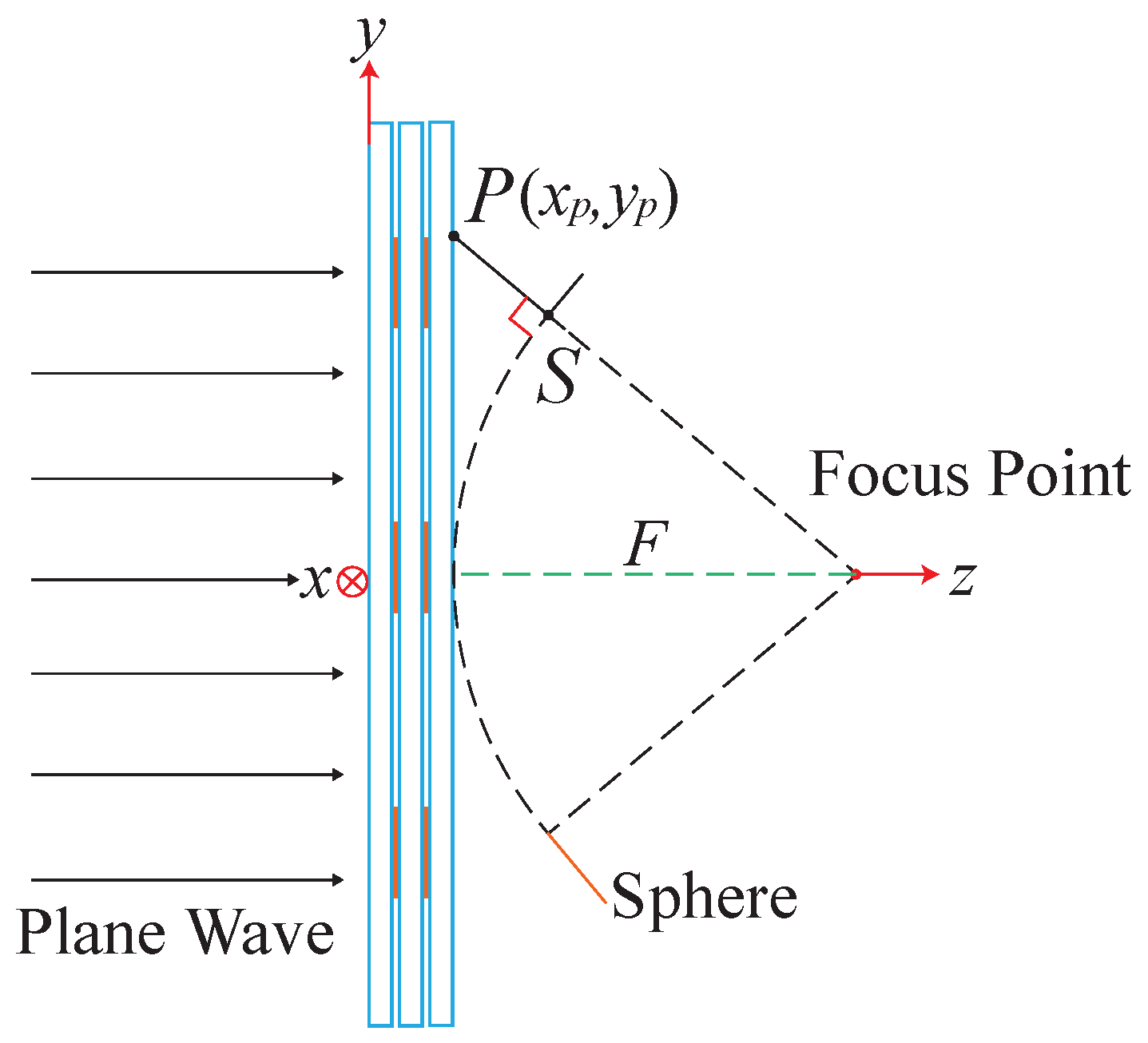
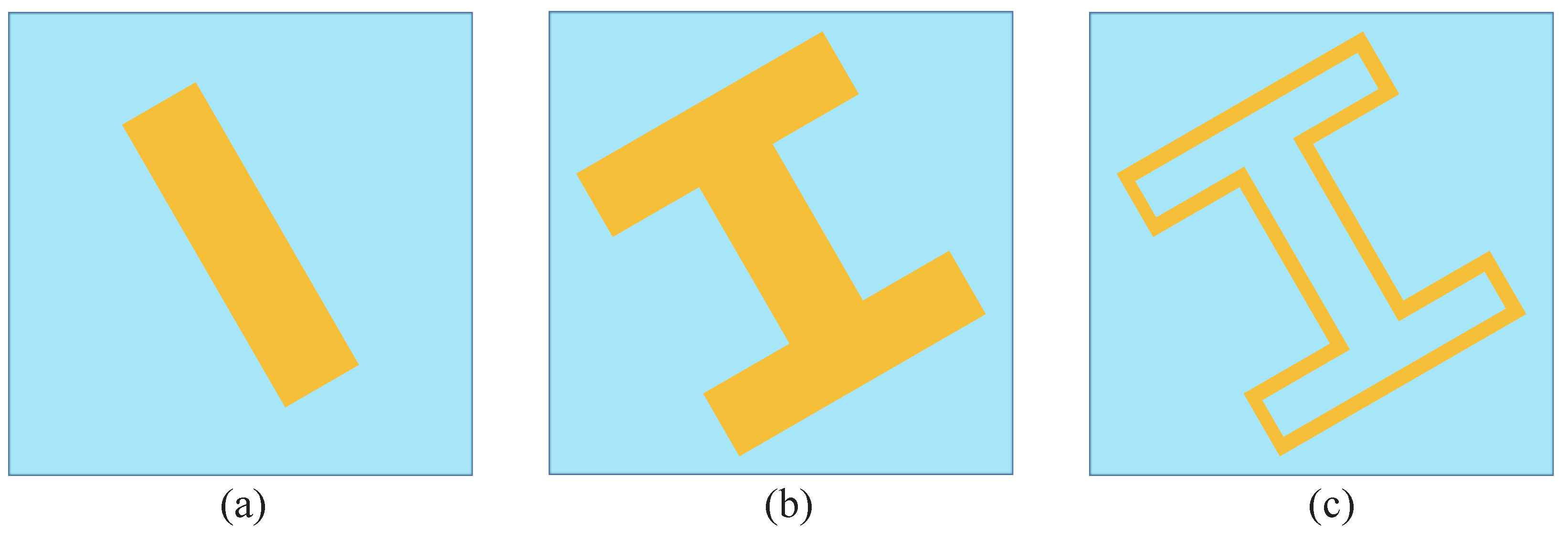
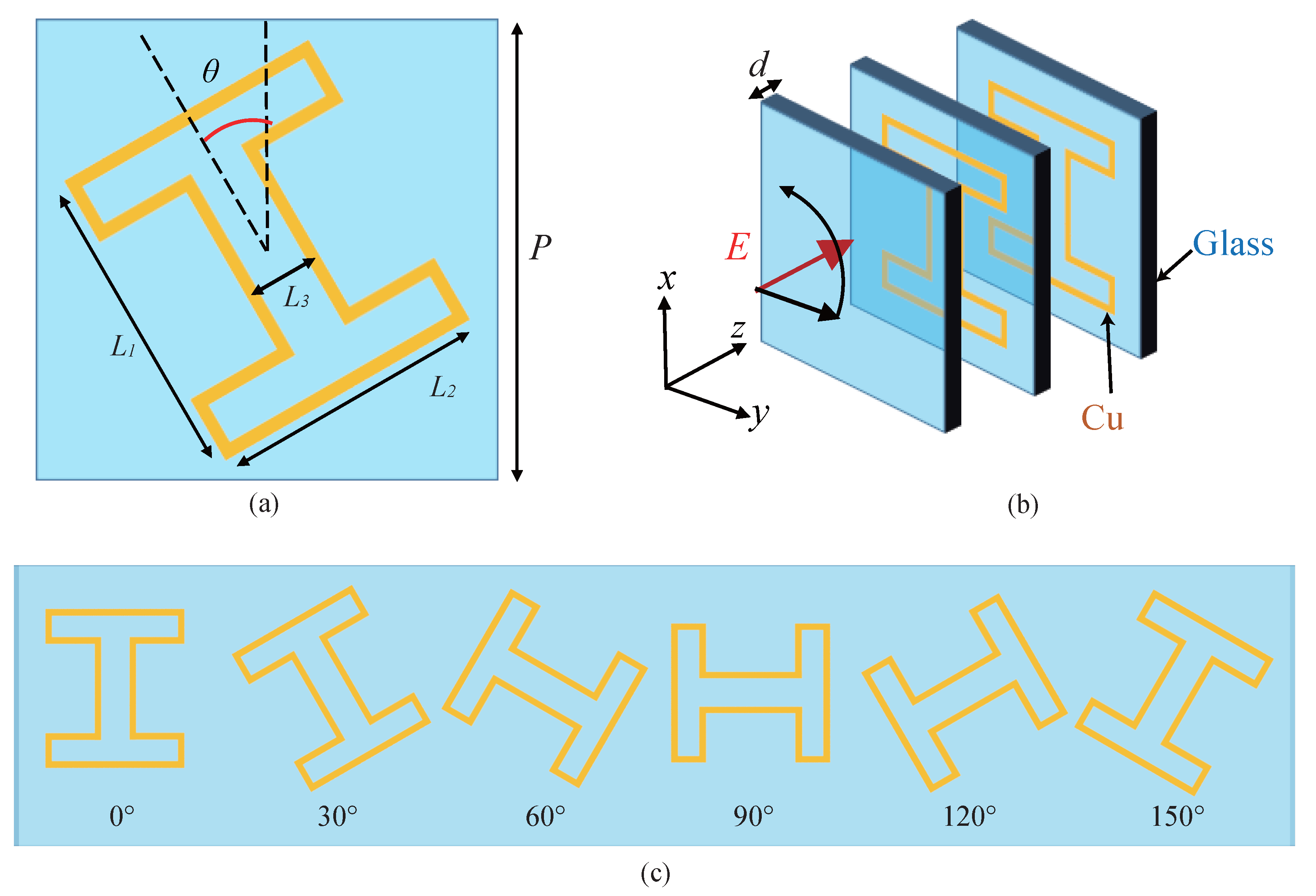

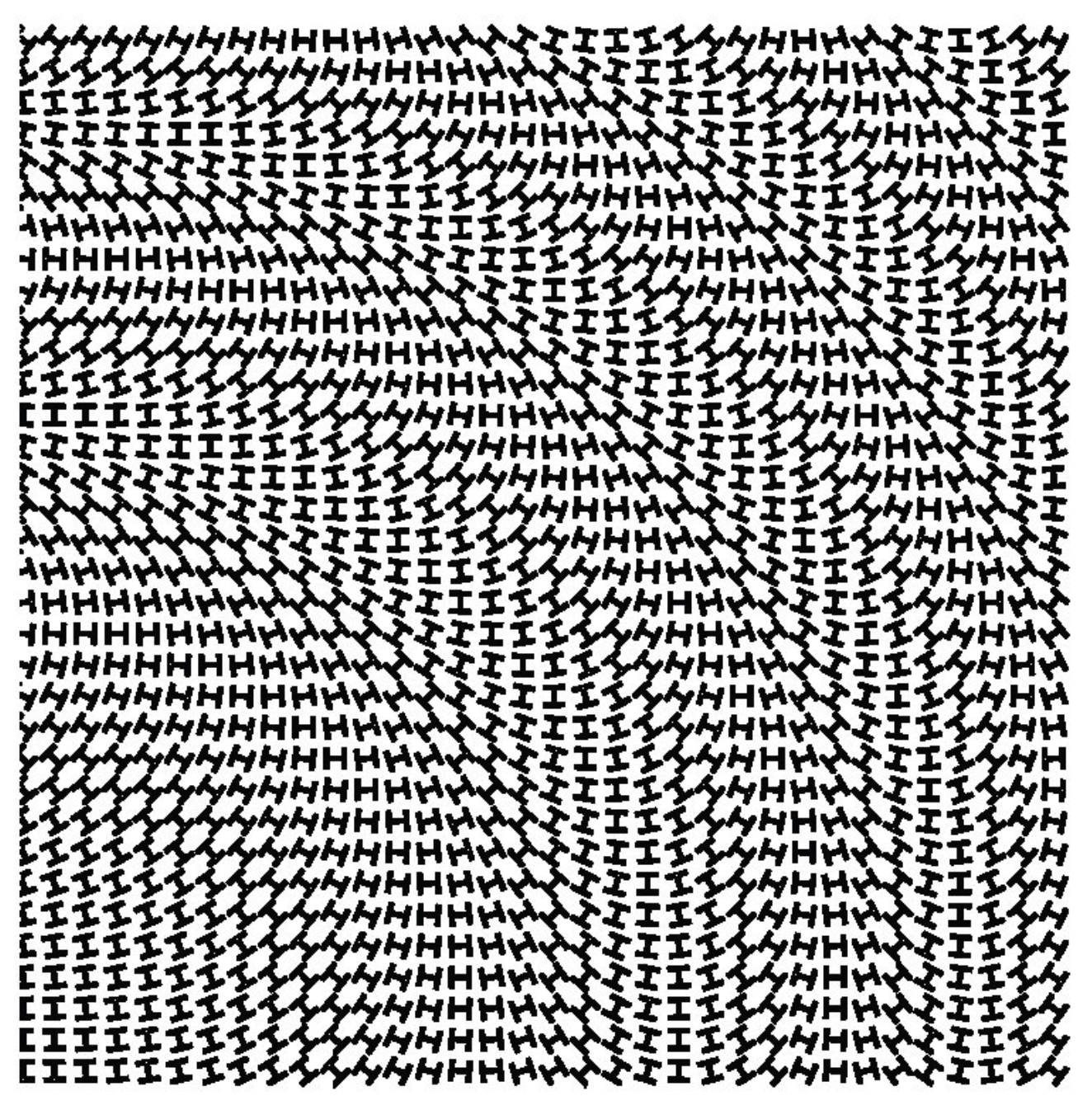
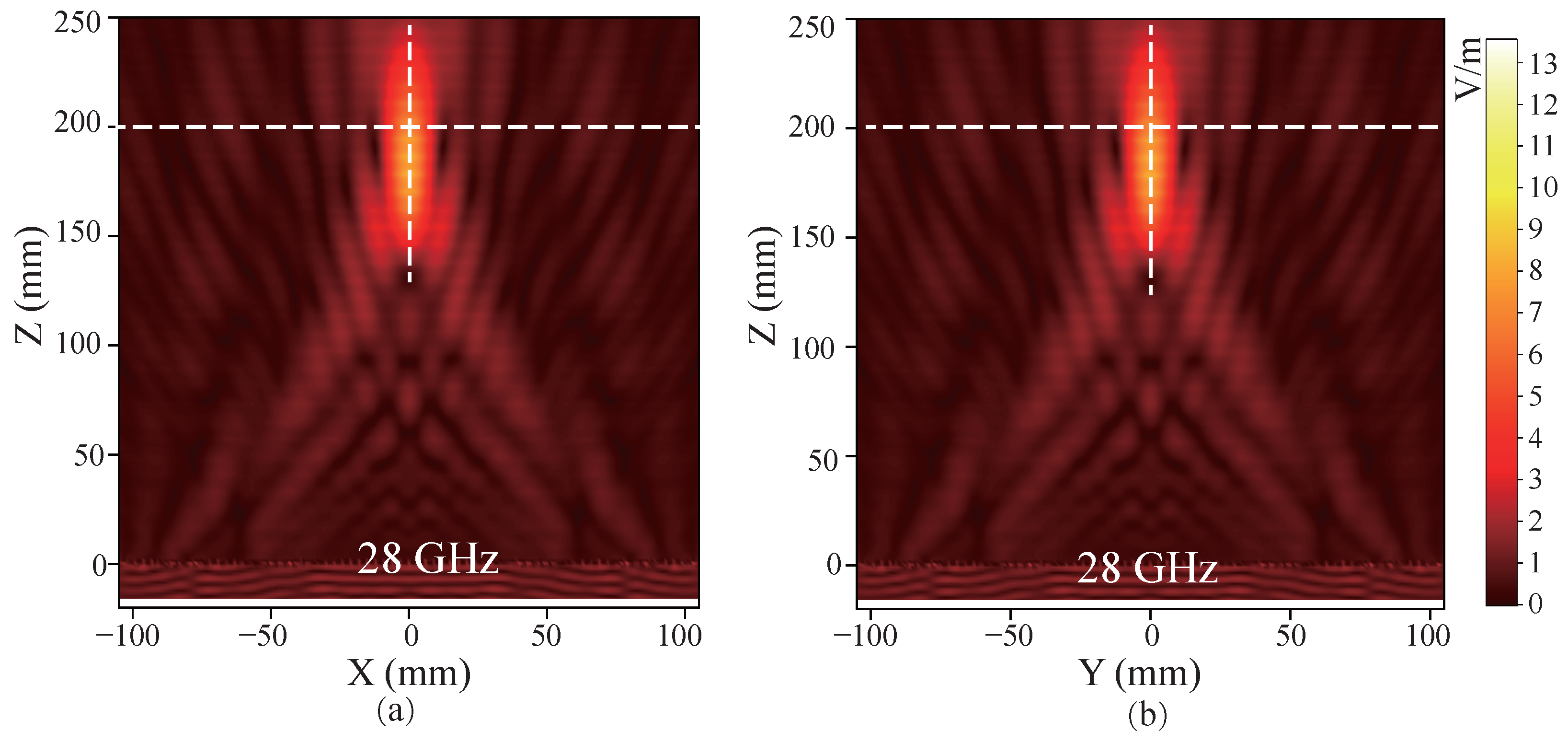
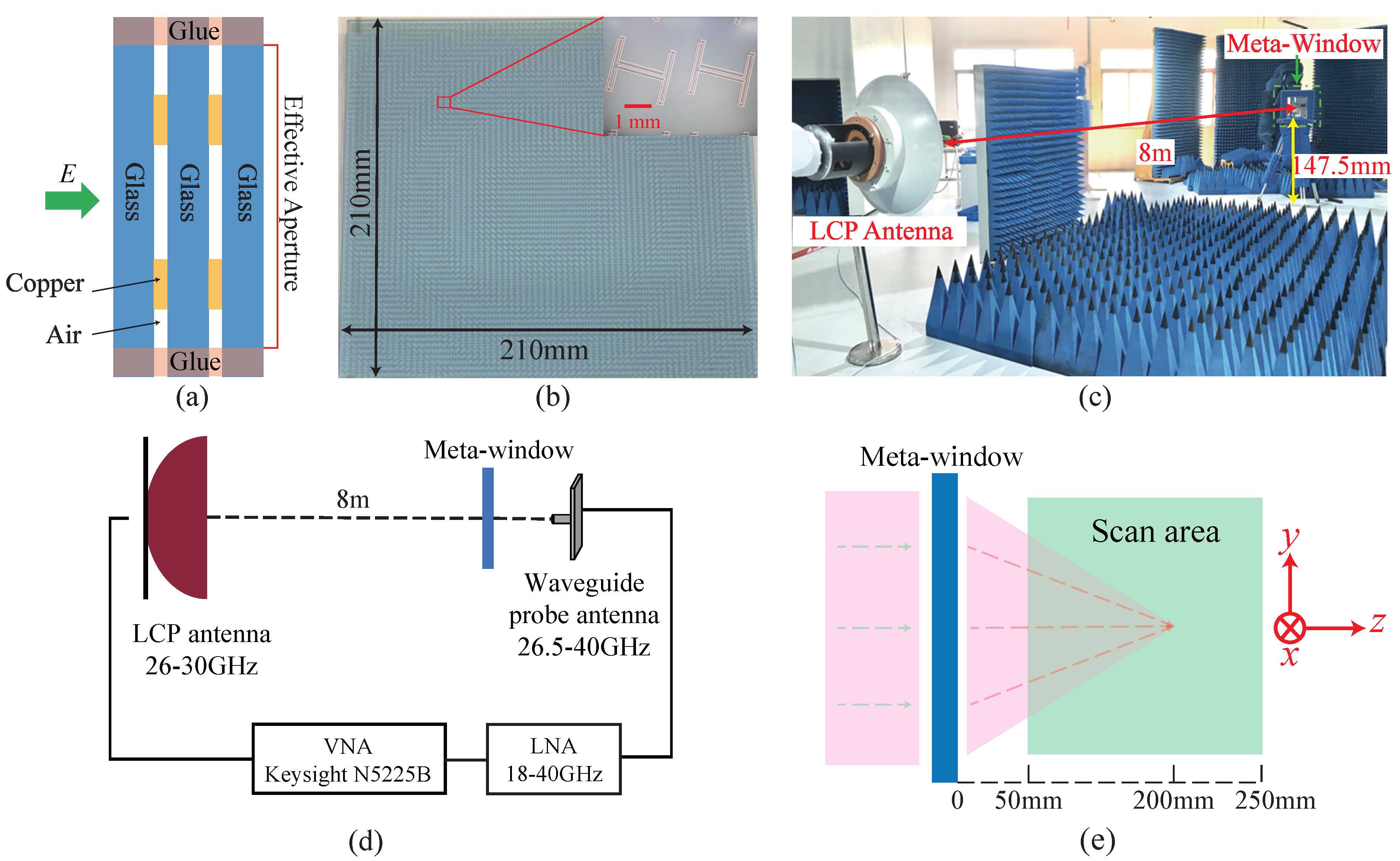
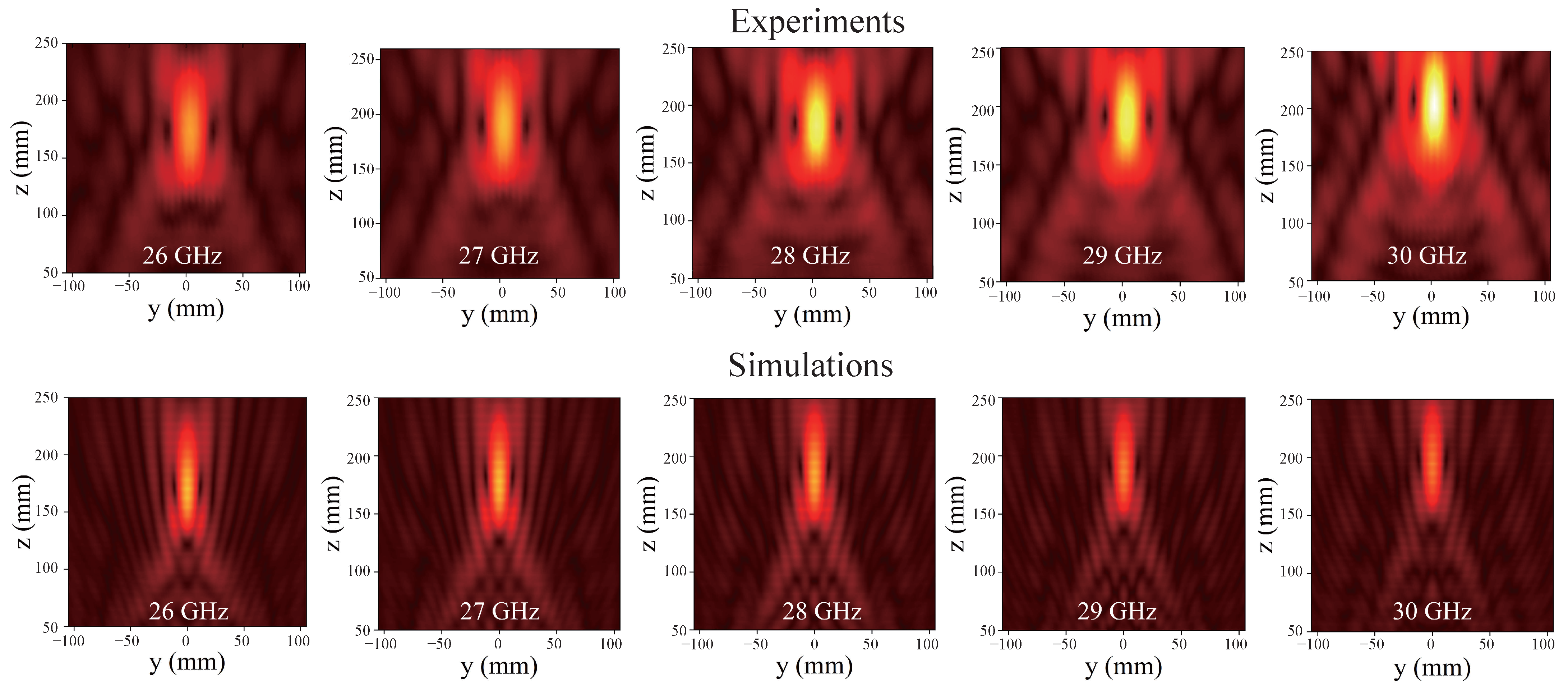


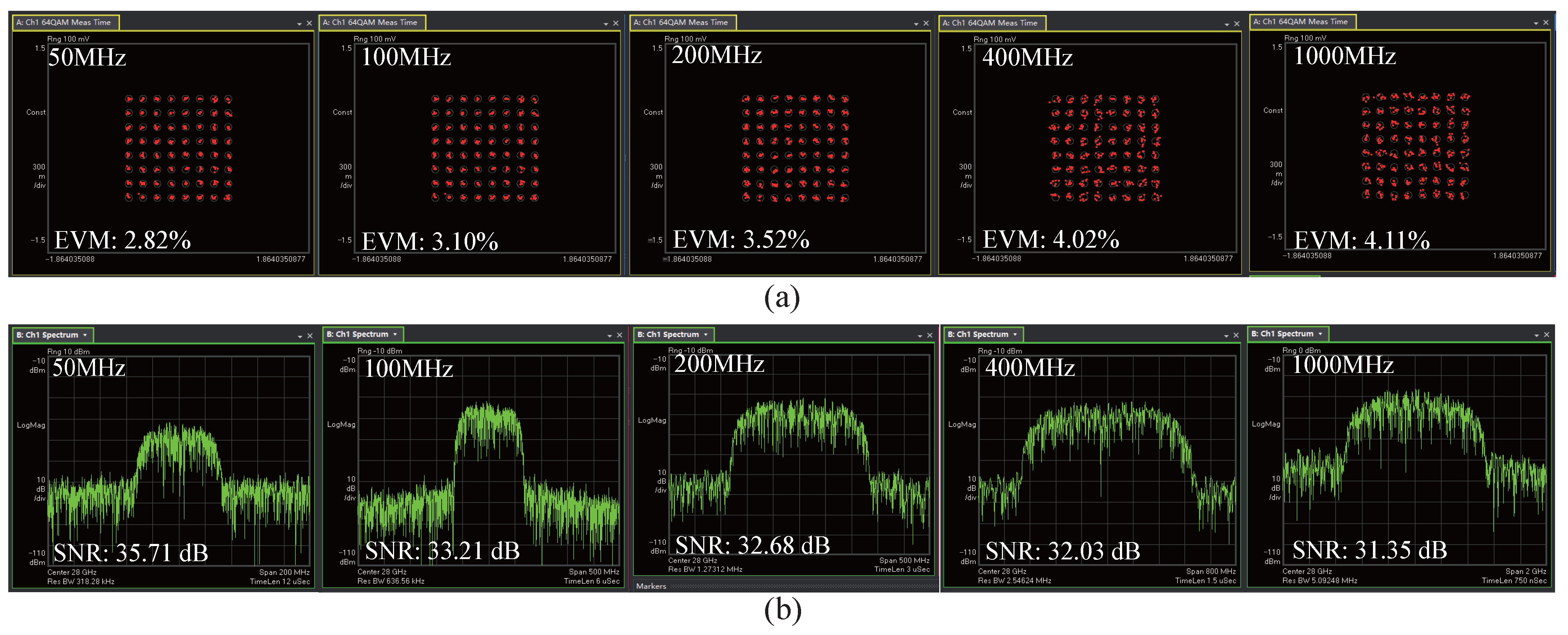
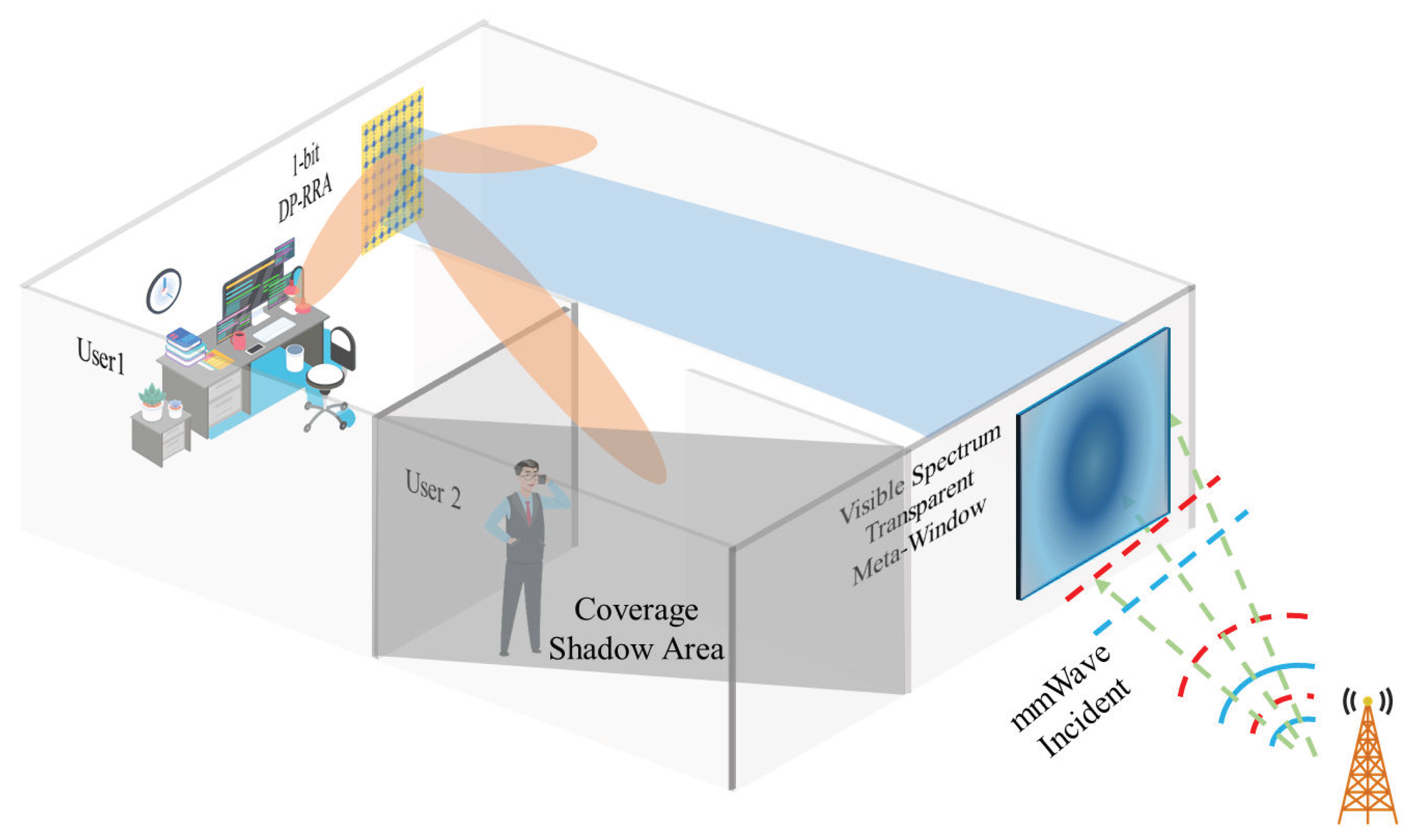
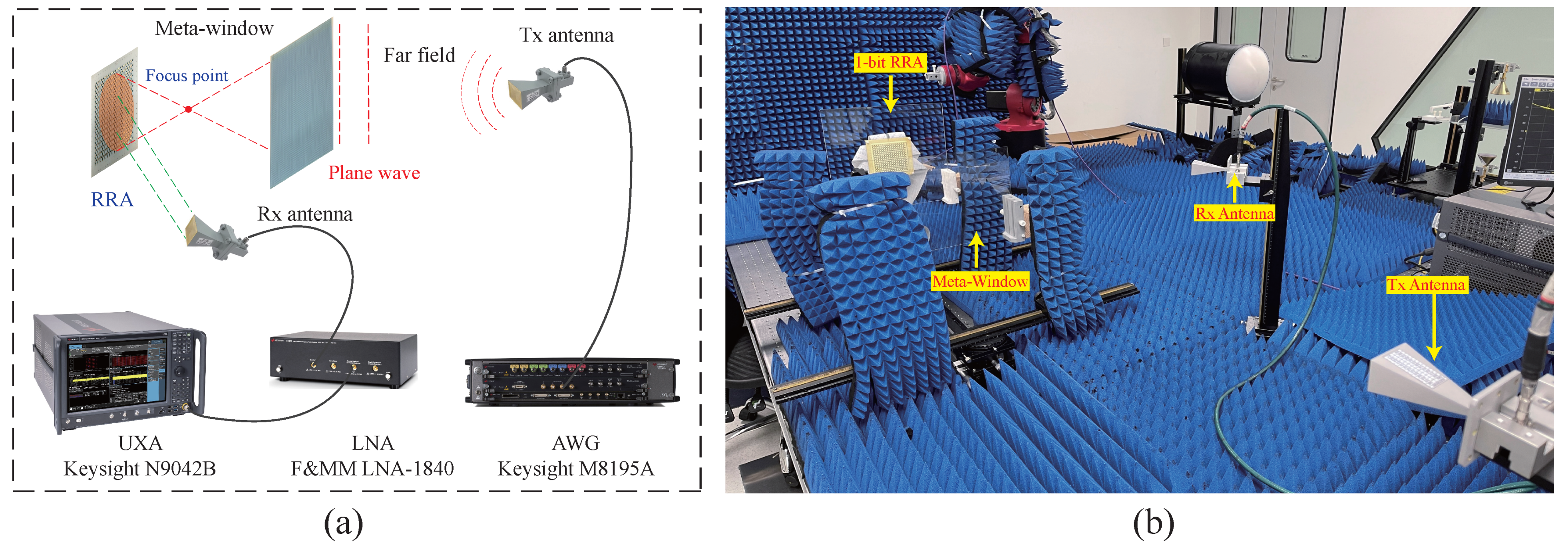
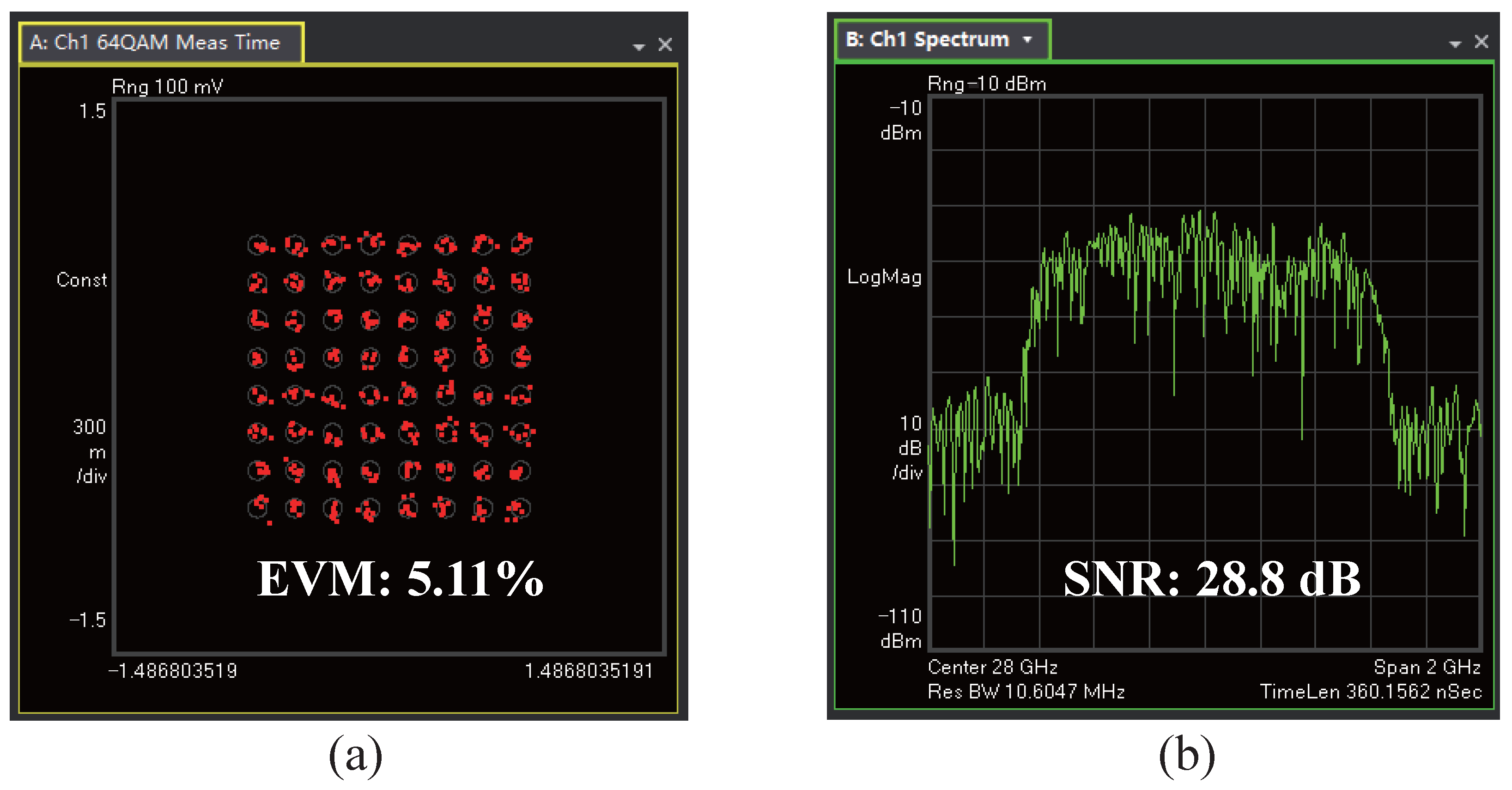
| Parameters | Value | Parameters | Value |
|---|---|---|---|
| P | 3 mm | t | 600 nm |
| 2 mm | 1.9 mm | ||
| 0.3 mm | w | 50 m | |
| d | 1.1 mm | n | 2 |
| BW (MHz) | Channel Power (dBm) | SNR (dB) | EVM | |||
|---|---|---|---|---|---|---|
|
Without
Meta-Window |
With
Meta-Window |
Without
Meta-Window |
With
Meta-Window |
Without
Meta-Window |
With
Meta-Window | |
| 50 | −67.50 | −46.31 | 17.21 | 35.71 | 14.35% | 2.82% |
| 100 | −68.14 | −46.57 | 14.23 | 33.21 | 24.22% | 3.10% |
| 200 | −68.66 | −47.03 | 11.58 | 32.68 | 64.32% | 3.52% |
| 400 | −69.42 | −48.22 | 10.31 | 32.03 | 84.32% | 4.02% |
| 1000 | −70.12 | −49.21 | 9.61 | 31.03 | 88.47% | 4.11% |
| Parameters | Value | Parameters | Value |
|---|---|---|---|
| Frequency (GHz) | 26–30 | Pol. | DP |
| Bit Num. | 1-bit | Diode Num. per unitcell | 2 |
| Scanning Angle | ±50 | Aperture Size () | 8.32 × 8.32 |
| Aperture Eff. | x: 13.3%, y: 15.7% | Element Num. | 256 |
| Deflection Angle | SNR | EVM |
|---|---|---|
| −40 | 27.30 dB | 6.21% |
| −30 | 28.80 dB | 5.11% |
| −20 | 29.50dB | 4.82% |
| −10 | 30.15 dB | 4.18% |
| 10 | 29.93 dB | 4.20% |
| 20 | 29.60 dB | 4.79% |
| 30 | 28.70 dB | 5.03% |
| 40 | 27.60 dB | 6.32% |
Disclaimer/Publisher’s Note: The statements, opinions and data contained in all publications are solely those of the individual author(s) and contributor(s) and not of MDPI and/or the editor(s). MDPI and/or the editor(s) disclaim responsibility for any injury to people or property resulting from any ideas, methods, instructions or products referred to in the content. |
© 2025 by the authors. Licensee MDPI, Basel, Switzerland. This article is an open access article distributed under the terms and conditions of the Creative Commons Attribution (CC BY) license (https://creativecommons.org/licenses/by/4.0/).
Share and Cite
Yang, C.; Yang, C.; Zhang, C.; Li, H. A Novel 28-GHz Meta-Window for Millimeter-Wave Indoor Coverage. Electronics 2025, 14, 1893. https://doi.org/10.3390/electronics14091893
Yang C, Yang C, Zhang C, Li H. A Novel 28-GHz Meta-Window for Millimeter-Wave Indoor Coverage. Electronics. 2025; 14(9):1893. https://doi.org/10.3390/electronics14091893
Chicago/Turabian StyleYang, Chun, Chuanchuan Yang, Cheng Zhang, and Hongbin Li. 2025. "A Novel 28-GHz Meta-Window for Millimeter-Wave Indoor Coverage" Electronics 14, no. 9: 1893. https://doi.org/10.3390/electronics14091893
APA StyleYang, C., Yang, C., Zhang, C., & Li, H. (2025). A Novel 28-GHz Meta-Window for Millimeter-Wave Indoor Coverage. Electronics, 14(9), 1893. https://doi.org/10.3390/electronics14091893







